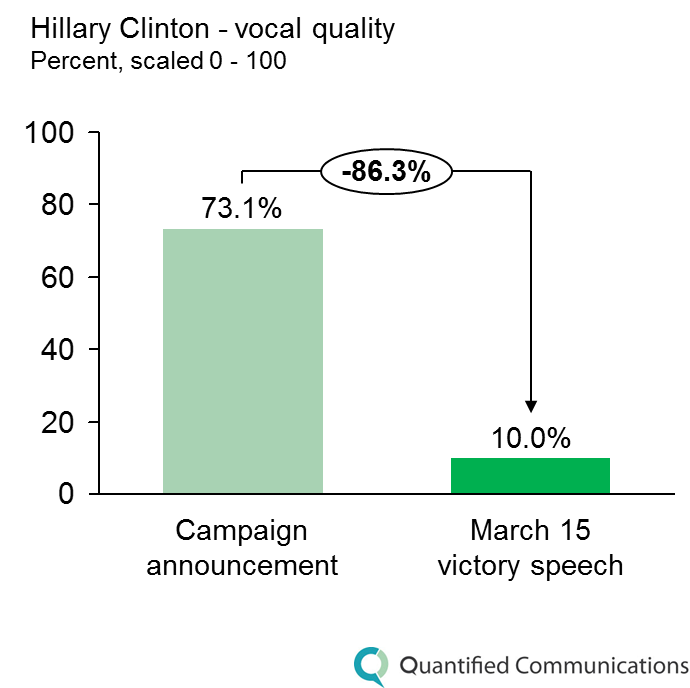Using Vocal Analytics to Measure Clinton’s Voice after 9 Months on the Campaign Trail


During her victory speech in Florida after Tuesday’s primaries, Hillary Clinton began to talk more about the general election than about the Democratic primary. Yet as publications such as NPR, Time, and Vox have noted, many pundits focused less on what she said and more on how she said it. Some suggested she ought to smile more, while others asked that she stop shouting at her audience.
Given that, for some of these pundits, Clinton’s delivery was distracting from her message, we decided to put our vocal analytics to work. We measured the former Secretary of State’s voice during last night’s victory speech and found that her intensity average — a measure of just how loudly she might’ve been shouting — was actually 4.5% lower than the average politician, and 4.9% lower than the average corporate speaker in our communications database.
Our vocal analysis did, however, pick up a creakiness in her voice. Her vocal quality – a measure of how breathy or creaky a voice is – was 88.4% less effective than the average speaker in our database. For comparison, we also analyzed Clinton’s voice in her campaign announcement from last June. You can immediately hear the difference in her voice between the two engagements. Her March 15 victory speech displayed 86.3% lower vocal quality than her campaign announcement.

A creaky voice can come across as tired as opposed to strong and confident. Executive communication expert Briar Goldberg says that when your voice sounds tired or weak, you’re sending the audience the message that you are tired or weak. She suggests protecting your vocal quality by managing your health — drinking plenty of water, avoiding dairy, and getting plenty of sleep leading up to a presentation — and by focusing on strong breath to improve the tone and quality of your voice.
The trick, which will sound familiar to anyone who spent time in choir during school, is to ensure you’re taking full, diaphragm-supported breaths, rather than shallow breaths that start in the chest. This deep, focused breathing will foster a strong, clear vocal tone, and even help calm those nerves.
While we don’t blame Hillary Clinton (or anyone, for that matter) for being tired after 9 months campaigning, it’s important for speakers to recognize that, in many cases, the sound of a voice can add to or detract from the overall message. Vocal analytics can help speakers identify the vocal cues they may be giving off without realizing it.
Read more on vocal analytics, and on how public speaking coaches work with this kind of data, from Quantified Communications.
To learn more about how our public speaking coaches can use vocal analytics to help prepare your executives for their presentations contact us at info@quantifiedcommuncations.com.


